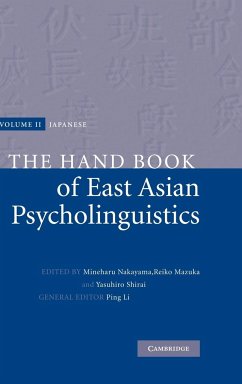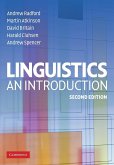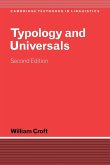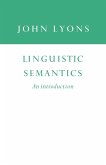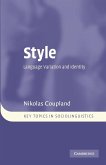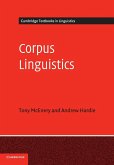Mineharu Nakayama / Reiko Mazuka / Yasuhiro Shirai / Ping Li (eds.)
Japanese
Herausgeber: Nakayama, Mineharu; Li, Ping; Mazuka, Reiko
Mineharu Nakayama / Reiko Mazuka / Yasuhiro Shirai / Ping Li (eds.)
Japanese
Herausgeber: Nakayama, Mineharu; Li, Ping; Mazuka, Reiko
- Gebundenes Buch
- Merkliste
- Auf die Merkliste
- Bewerten Bewerten
- Teilen
- Produkt teilen
- Produkterinnerung
- Produkterinnerung
A large body of knowledge has accumulated in recent years on the cognitive processes and mechanisms underlying language. Much of this knowledge has come from studies of Indo-European languages, particularly English. This handbook, the second in a three-volume series on East Asian psycholinguistics, presents a state-of-the-art discussion of the psycholinguistic study of Japanese. A language of growing interest to linguists, Japanese differs significantly from Indo-European languages in its grammar, its lexicon, and its written and spoken forms - features which have profound implications for the learning, representation and processing of language.…mehr
Andere Kunden interessierten sich auch für
![Linguistics Linguistics]() Andrew RadfordLinguistics46,99 €
Andrew RadfordLinguistics46,99 €![Grammaticalization Grammaticalization]() Paul J. HopperGrammaticalization66,99 €
Paul J. HopperGrammaticalization66,99 €![Typology and Universals Typology and Universals]() William CroftTypology and Universals59,99 €
William CroftTypology and Universals59,99 €![Linguistic Semantics Linguistic Semantics]() John LyonsLinguistic Semantics71,99 €
John LyonsLinguistic Semantics71,99 €![Style Style]() Nikolas CouplandStyle49,99 €
Nikolas CouplandStyle49,99 €![The Syntax of Agreement and Concord The Syntax of Agreement and Concord]() Mark C. BakerThe Syntax of Agreement and Concord54,99 €
Mark C. BakerThe Syntax of Agreement and Concord54,99 €![Corpus Linguistics Corpus Linguistics]() Tony McEneryCorpus Linguistics33,99 €
Tony McEneryCorpus Linguistics33,99 €-
-
-
A large body of knowledge has accumulated in recent years on the cognitive processes and mechanisms underlying language. Much of this knowledge has come from studies of Indo-European languages, particularly English. This handbook, the second in a three-volume series on East Asian psycholinguistics, presents a state-of-the-art discussion of the psycholinguistic study of Japanese. A language of growing interest to linguists, Japanese differs significantly from Indo-European languages in its grammar, its lexicon, and its written and spoken forms - features which have profound implications for the learning, representation and processing of language.
Hinweis: Dieser Artikel kann nur an eine deutsche Lieferadresse ausgeliefert werden.
Hinweis: Dieser Artikel kann nur an eine deutsche Lieferadresse ausgeliefert werden.
Produktdetails
- Produktdetails
- Verlag: Cambridge University Press
- Seitenzahl: 428
- Erscheinungstermin: 28. Oktober 2011
- Englisch
- Abmessung: 235mm x 157mm x 30mm
- Gewicht: 842g
- ISBN-13: 9780521833349
- ISBN-10: 0521833345
- Artikelnr.: 21288313
- Herstellerkennzeichnung
- Libri GmbH
- Europaallee 1
- 36244 Bad Hersfeld
- gpsr@libri.de
- Verlag: Cambridge University Press
- Seitenzahl: 428
- Erscheinungstermin: 28. Oktober 2011
- Englisch
- Abmessung: 235mm x 157mm x 30mm
- Gewicht: 842g
- ISBN-13: 9780521833349
- ISBN-10: 0521833345
- Artikelnr.: 21288313
- Herstellerkennzeichnung
- Libri GmbH
- Europaallee 1
- 36244 Bad Hersfeld
- gpsr@libri.de
Ping Li is Associate Professor of Psychology at the University of Richmond.
Mineharu Nakayama is Associate Professor in the Department of East Asian Languages and Literatures, The Ohio State University.
Reiko Mazuka is Head of the Laboratory for Language Development at the RIKEN Brain Science Institute, Japan, and also Associate Professor in the Department of Psychology, Duke University.
Yasuhiro Shirai is Professor of Linguistics in the Department of Linguistics at the University of Pittsburgh.
Mineharu Nakayama is Associate Professor in the Department of East Asian Languages and Literatures, The Ohio State University.
Reiko Mazuka is Head of the Laboratory for Language Development at the RIKEN Brain Science Institute, Japan, and also Associate Professor in the Department of Psychology, Duke University.
Yasuhiro Shirai is Professor of Linguistics in the Department of Linguistics at the University of Pittsburgh.
Part I. Language Acquisition: 1. Ontogeny of language Nubou Masataka
2. Caregiver's speech Toshiki Murase and Tamiko Ogura
3. The intrinsic linkage between gesture and speech in the prelinguistic stage Keiko Ejiri and Nobuko Uchida
4. Infant speech perception Akiko Hayashi
5. Phonological acquisition Mitsuhiko Ohta
6. Mechanism of lexical development: implications from Japanese children's word learning Mutsumi Imai
7. The acquisition of nouns and verbs in Japanese Yuriko Oshima-Takane
8. The acquisition of verbal nouns Yutaka Sato and Yoshi Yamashita
9. The acquisition of Japanese numeral classifiers Kasumi Yamamoto
10. The acquisition of case markers Hiromi Morikawa
11. The acquisition of tense and aspect Yasuhiro Shirai
12. On the origin of children's errors: the case of Japanese negation and direct passive Tetsuya Sano
13. Binding theory in UG and first language acquisition of Japanese Barbara Lust
14. The acquisition of the particles, 'ne', 'yo' and 'no' Haruko Minegishi Cook
15. The acquisition of linguistic politeness in Japanese Keiko Nakamura
16. Children's narrative structures Masahiko Minami
17. Memory talk and testimony in children Makiko Naka
18. Developmental dyslexia Jun Yamada
19. Japanese sign language Takashi Torigoe
20. The role of an innate acquisition device in second language acquisition Kazue Kanno
21. Japanese, the grammar of reflexives, and second language acquisition Margaret Thomas
22. Processes in L2 Japanese sentence production Noriko Iwasaki
23. Development of lexical competence among second-language readers Keiko Koda
24. Reading in Japanese as a second language Yukie Horiba
25. International code-switching in Japanese and English Miwa Nishimura
Part II. Language Processing: 26. Phonetic and phonological organizations of speech in Japanese Haruo Kubozono
27. Speech segmentation by Japanese listeners: its language-specificity and language-universality Takashi Otake
28. Prosody in sentence processing Jennifer Venditti
29. Speech errors Yasushi Terao
30. Effects of word properties on Japanese sentence processing Tadahisa Kondo and Reiko Mazuka
31. Orthographic processing Hirofumi Saito
32. Lexical access Taeko Wydell
33. Incrementality in Japanese sentence processing Yuki Kamide
34. Processing alternative word orders Edson Miyamoto
35. Processing of relative clauses in Japanese: coping with multiple ambiguities Yuki Hirose
36. Processing of empty categories in Japanese Tsutomu Sakamoto
37. Difficulty of certain sentence constructions in comprehension Mineharu Nakayama, Shravan Vashisth and Richard L. Lewis
38. Reading and working memory Mariko Osaka
39. Sentence production in Japanese Hiroko Yamashita and Franklin Chang
40. Neural basis of syntactic processing in Japanese Hiroko Hagiwara
41. The competition model Yoshinori Sasaki and Brian McWhinney
42. Connectionist models Michiro Negishi
43. Computational linguistics Masayuki Asahara, Yasuharu Den and Yuji Matsumoto
44. Language and gesture as a single communicative system Nobuhiro Furuyama.
2. Caregiver's speech Toshiki Murase and Tamiko Ogura
3. The intrinsic linkage between gesture and speech in the prelinguistic stage Keiko Ejiri and Nobuko Uchida
4. Infant speech perception Akiko Hayashi
5. Phonological acquisition Mitsuhiko Ohta
6. Mechanism of lexical development: implications from Japanese children's word learning Mutsumi Imai
7. The acquisition of nouns and verbs in Japanese Yuriko Oshima-Takane
8. The acquisition of verbal nouns Yutaka Sato and Yoshi Yamashita
9. The acquisition of Japanese numeral classifiers Kasumi Yamamoto
10. The acquisition of case markers Hiromi Morikawa
11. The acquisition of tense and aspect Yasuhiro Shirai
12. On the origin of children's errors: the case of Japanese negation and direct passive Tetsuya Sano
13. Binding theory in UG and first language acquisition of Japanese Barbara Lust
14. The acquisition of the particles, 'ne', 'yo' and 'no' Haruko Minegishi Cook
15. The acquisition of linguistic politeness in Japanese Keiko Nakamura
16. Children's narrative structures Masahiko Minami
17. Memory talk and testimony in children Makiko Naka
18. Developmental dyslexia Jun Yamada
19. Japanese sign language Takashi Torigoe
20. The role of an innate acquisition device in second language acquisition Kazue Kanno
21. Japanese, the grammar of reflexives, and second language acquisition Margaret Thomas
22. Processes in L2 Japanese sentence production Noriko Iwasaki
23. Development of lexical competence among second-language readers Keiko Koda
24. Reading in Japanese as a second language Yukie Horiba
25. International code-switching in Japanese and English Miwa Nishimura
Part II. Language Processing: 26. Phonetic and phonological organizations of speech in Japanese Haruo Kubozono
27. Speech segmentation by Japanese listeners: its language-specificity and language-universality Takashi Otake
28. Prosody in sentence processing Jennifer Venditti
29. Speech errors Yasushi Terao
30. Effects of word properties on Japanese sentence processing Tadahisa Kondo and Reiko Mazuka
31. Orthographic processing Hirofumi Saito
32. Lexical access Taeko Wydell
33. Incrementality in Japanese sentence processing Yuki Kamide
34. Processing alternative word orders Edson Miyamoto
35. Processing of relative clauses in Japanese: coping with multiple ambiguities Yuki Hirose
36. Processing of empty categories in Japanese Tsutomu Sakamoto
37. Difficulty of certain sentence constructions in comprehension Mineharu Nakayama, Shravan Vashisth and Richard L. Lewis
38. Reading and working memory Mariko Osaka
39. Sentence production in Japanese Hiroko Yamashita and Franklin Chang
40. Neural basis of syntactic processing in Japanese Hiroko Hagiwara
41. The competition model Yoshinori Sasaki and Brian McWhinney
42. Connectionist models Michiro Negishi
43. Computational linguistics Masayuki Asahara, Yasuharu Den and Yuji Matsumoto
44. Language and gesture as a single communicative system Nobuhiro Furuyama.
Part I. Language Acquisition: 1. Ontogeny of language Nubou Masataka
2. Caregiver's speech Toshiki Murase and Tamiko Ogura
3. The intrinsic linkage between gesture and speech in the prelinguistic stage Keiko Ejiri and Nobuko Uchida
4. Infant speech perception Akiko Hayashi
5. Phonological acquisition Mitsuhiko Ohta
6. Mechanism of lexical development: implications from Japanese children's word learning Mutsumi Imai
7. The acquisition of nouns and verbs in Japanese Yuriko Oshima-Takane
8. The acquisition of verbal nouns Yutaka Sato and Yoshi Yamashita
9. The acquisition of Japanese numeral classifiers Kasumi Yamamoto
10. The acquisition of case markers Hiromi Morikawa
11. The acquisition of tense and aspect Yasuhiro Shirai
12. On the origin of children's errors: the case of Japanese negation and direct passive Tetsuya Sano
13. Binding theory in UG and first language acquisition of Japanese Barbara Lust
14. The acquisition of the particles, 'ne', 'yo' and 'no' Haruko Minegishi Cook
15. The acquisition of linguistic politeness in Japanese Keiko Nakamura
16. Children's narrative structures Masahiko Minami
17. Memory talk and testimony in children Makiko Naka
18. Developmental dyslexia Jun Yamada
19. Japanese sign language Takashi Torigoe
20. The role of an innate acquisition device in second language acquisition Kazue Kanno
21. Japanese, the grammar of reflexives, and second language acquisition Margaret Thomas
22. Processes in L2 Japanese sentence production Noriko Iwasaki
23. Development of lexical competence among second-language readers Keiko Koda
24. Reading in Japanese as a second language Yukie Horiba
25. International code-switching in Japanese and English Miwa Nishimura
Part II. Language Processing: 26. Phonetic and phonological organizations of speech in Japanese Haruo Kubozono
27. Speech segmentation by Japanese listeners: its language-specificity and language-universality Takashi Otake
28. Prosody in sentence processing Jennifer Venditti
29. Speech errors Yasushi Terao
30. Effects of word properties on Japanese sentence processing Tadahisa Kondo and Reiko Mazuka
31. Orthographic processing Hirofumi Saito
32. Lexical access Taeko Wydell
33. Incrementality in Japanese sentence processing Yuki Kamide
34. Processing alternative word orders Edson Miyamoto
35. Processing of relative clauses in Japanese: coping with multiple ambiguities Yuki Hirose
36. Processing of empty categories in Japanese Tsutomu Sakamoto
37. Difficulty of certain sentence constructions in comprehension Mineharu Nakayama, Shravan Vashisth and Richard L. Lewis
38. Reading and working memory Mariko Osaka
39. Sentence production in Japanese Hiroko Yamashita and Franklin Chang
40. Neural basis of syntactic processing in Japanese Hiroko Hagiwara
41. The competition model Yoshinori Sasaki and Brian McWhinney
42. Connectionist models Michiro Negishi
43. Computational linguistics Masayuki Asahara, Yasuharu Den and Yuji Matsumoto
44. Language and gesture as a single communicative system Nobuhiro Furuyama.
2. Caregiver's speech Toshiki Murase and Tamiko Ogura
3. The intrinsic linkage between gesture and speech in the prelinguistic stage Keiko Ejiri and Nobuko Uchida
4. Infant speech perception Akiko Hayashi
5. Phonological acquisition Mitsuhiko Ohta
6. Mechanism of lexical development: implications from Japanese children's word learning Mutsumi Imai
7. The acquisition of nouns and verbs in Japanese Yuriko Oshima-Takane
8. The acquisition of verbal nouns Yutaka Sato and Yoshi Yamashita
9. The acquisition of Japanese numeral classifiers Kasumi Yamamoto
10. The acquisition of case markers Hiromi Morikawa
11. The acquisition of tense and aspect Yasuhiro Shirai
12. On the origin of children's errors: the case of Japanese negation and direct passive Tetsuya Sano
13. Binding theory in UG and first language acquisition of Japanese Barbara Lust
14. The acquisition of the particles, 'ne', 'yo' and 'no' Haruko Minegishi Cook
15. The acquisition of linguistic politeness in Japanese Keiko Nakamura
16. Children's narrative structures Masahiko Minami
17. Memory talk and testimony in children Makiko Naka
18. Developmental dyslexia Jun Yamada
19. Japanese sign language Takashi Torigoe
20. The role of an innate acquisition device in second language acquisition Kazue Kanno
21. Japanese, the grammar of reflexives, and second language acquisition Margaret Thomas
22. Processes in L2 Japanese sentence production Noriko Iwasaki
23. Development of lexical competence among second-language readers Keiko Koda
24. Reading in Japanese as a second language Yukie Horiba
25. International code-switching in Japanese and English Miwa Nishimura
Part II. Language Processing: 26. Phonetic and phonological organizations of speech in Japanese Haruo Kubozono
27. Speech segmentation by Japanese listeners: its language-specificity and language-universality Takashi Otake
28. Prosody in sentence processing Jennifer Venditti
29. Speech errors Yasushi Terao
30. Effects of word properties on Japanese sentence processing Tadahisa Kondo and Reiko Mazuka
31. Orthographic processing Hirofumi Saito
32. Lexical access Taeko Wydell
33. Incrementality in Japanese sentence processing Yuki Kamide
34. Processing alternative word orders Edson Miyamoto
35. Processing of relative clauses in Japanese: coping with multiple ambiguities Yuki Hirose
36. Processing of empty categories in Japanese Tsutomu Sakamoto
37. Difficulty of certain sentence constructions in comprehension Mineharu Nakayama, Shravan Vashisth and Richard L. Lewis
38. Reading and working memory Mariko Osaka
39. Sentence production in Japanese Hiroko Yamashita and Franklin Chang
40. Neural basis of syntactic processing in Japanese Hiroko Hagiwara
41. The competition model Yoshinori Sasaki and Brian McWhinney
42. Connectionist models Michiro Negishi
43. Computational linguistics Masayuki Asahara, Yasuharu Den and Yuji Matsumoto
44. Language and gesture as a single communicative system Nobuhiro Furuyama.

